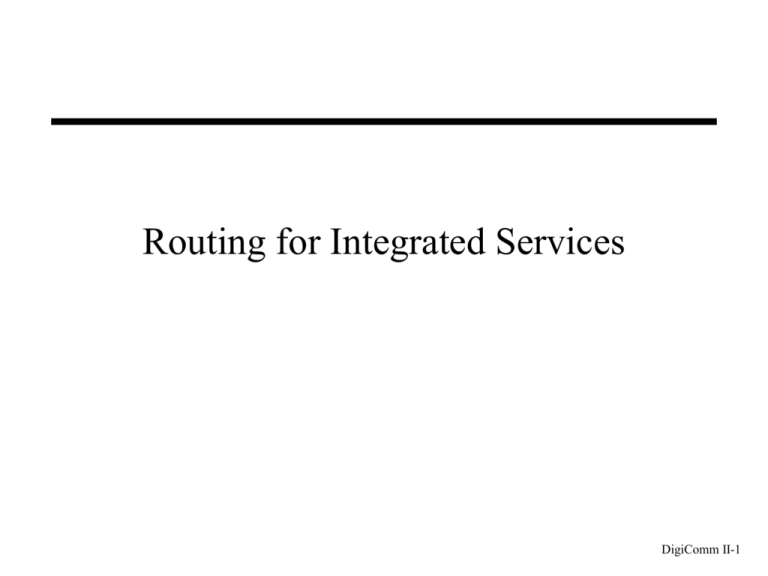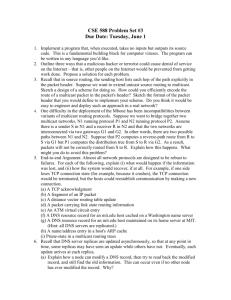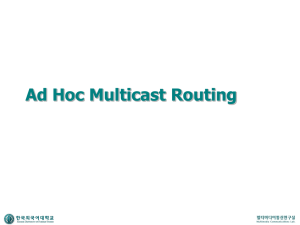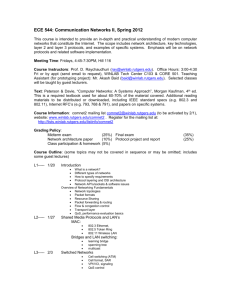QoS Routing, lecture 18
advertisement

Routing for Integrated Services DigiComm II-1 New routing requirements • Multiparty communication: • • • • • • • conferencing (audio, video, whiteboard) remote teaching multi-user games networked entertainment – “live broadcasts” (distributed simulations) (software distribution) (news distribution) • Support for QoS in routing DigiComm II-2 Questions • How can we support multiparty communication? • How can we provide QoS support in routing? DigiComm II-3 Many-to-many communication: IP multicast DigiComm II-4 Group communication using IP • Many-to-many: • many senders and receivers • host group or multicast group • One transmission, many receivers • Optimise transmissions: • e.g. reduce duplication • Class D IP address: • 224.0.0.0 - 239.255.255.255 • not a single host interface • some addresses reserved • Applications: • • • • • conferencing software update/distribution news distribution mutli-player games distributed simulations • Network support: • LAN • WAN (Internet routers) • scoped transmission: IP TTL header field DigiComm II-5 IP multicast and IGMP • Features of IP multicast: • group of hosts • Class D address • leaf nodes (hosts) and intermediate nodes (routers) • dynamic membership, leafinitiated join • non-group member can A send to group • multicast capable routers • local delivery mechanism B network The multicast capable router listens in multicast promiscuous mode so that it can pick up all mulitcast packets for relay off the LAN if required. C has sent report with destination address X so if A and B want to become members, the do not need to send an IGMPREPORT • IGMP: group membership control C C wishes to join group X, so sends IGMPREPORT (after random timeout) periodic IGMPQUERY from router DigiComm II-6 Multicast: LAN • Need to translate to MAC address • Algorithmic resolution: IPv4 multicast address 224.20.5.1 1110 0000 0001 0100 0000 0101 0000 0001 • quick, easy, distributed • MAC address format: • IANA MAC address allocation • last 23-bits of Class D • not 1-1 mapping IANA MAC ADDRESS PREFIX 0000 0001 0000 0000 0101 1110 0--- ---- ---- ---- ---- Final Ethernet multicast address 0000 0001 0000 0000 0101 1110 0100 0000 0101 0000 0001 • Host filtering required at IP layer DigiComm II-7 Multicast routing [1] S R S R B S R R R C D B C R R D C R E E R F F R R R B E F • First refinement • reverse path broadcast (RPB) • duplication • Starting point: flood • creates looping DigiComm II-8 Multicast routing [2] • Distance vector: • need next hop information • (or use poisoned reverse) R S R R C D • Link state: R R R B E F • construction of all SP trees for all nodes possible • “tie-break” rules required • Second refinement • eliminate duplicates • need routing information DigiComm II-9 Multicast routing [3] a) R b) R S S R R R C D C R R R R B E B E • Third refinement: • pruning • need to refresh tree – soft-state • reverse path multicasting (RPM) • RPM: • used in many multicast protocols • per-sender, per-group state • Networks with no group members pruned from tree • Must somehow allow tree to re-grow • Soft-state: • timeout – re-flood • downstream nodes prune again • Explicit graft: • downstream nodes join tree DigiComm II-10 DVMRP and the MBONE • DVMRP: • RPM • used on MBONE • MBONE: • virtual overlay network • distance vector routing MBONE Visualisation Tools http://www.caida.org/Tools/Manta/ http://www.caida.org/Tools/Otter/Mbone/ DigiComm II-11 MBONE configuration • Routers not multicast aware: G to MBONE M • use virtual network • Multicast islands: • connected by virtual links • can not use normal routing info – use multicast hops G • IP tunnelling: M • software runs on a host • ad hoc topology • Use TTL for scope: • TTL expiry: silent discard • administrative scope possible G M M router IP-in-IP tunnel multicast routing software DigiComm II-12 MOSPF • • • • Link-state algorithm RPM Intended for larger networks Soft-state: • router advertisement sent on group join • tree evaluated as routing update for a group arrives • Still suffers from scaling problems: • a lot of state-required at each router • per-group, per-link information required DigiComm II-13 CBT • Core router(s): • core distribution point for group • Leaf sends IGMP request • Local router sends join request to core • Join request routed to core via normal unicast Intermediate routers note only incoming i/f and outgoing i/f per group Explicit join and leave: • no pruning • no flooding Distribution tree may be sub-optimal Core is bottleneck and single-point-of-failure: • additional core maybe possible • Careful core placement required DigiComm II-14 PIM • PIM: • can use any unicast routing protocol info • two modes: dense mode and sparse mode • Dense mode: • RPM • flood-and-prune with explicit join • Sparse mode: • similar to CBT • core (rendezvous point) or shortest-path possible • rendezvous point sends keep-alive • explicit graft to tree DigiComm II-15 Multicast address management • Some addresses are reserved: • 224.0.0.1 all systems on this sub-net 224.0.0.2 all routers on this sub-net 224.0.0.4 all DVMRP routers (plus many others) • No central control as in unicast addresses • Others generated pseudo-randomly: • 28-bit multicast ID (last 28 bits of Class D address) DigiComm II-16 Multimedia conferencing [1] • Multimedia applications: • • • • voice - RAT video - VIC text - NTE whiteboard - WBD • Support: • session directory - SDR • gateway - UTG • All use IP multicast: • local – direct • wide area – MBONE • RTP/RTCP • IP multicast: • 224.2.0.0 - 224.2.255.255 • different address per application per session • Scoping: • IP TTL header field: 16 local (site) 47 UK 63 Europe 127 world • administrative DigiComm II-17 Multimedia conferencing [2] • Two multicast channels per application per session: • RTCP and RTCP • Stand-alone - ad hoc: • individual applications • Advertised conference: • SDR • configuration information multicast-capable routers MBONE (Internet) DigiComm II-18 Multimedia conferencing [3] • Inter-flow synchronisation: • e.g. audio-video (lip-synch) • RTP/RCTP time-stamps • e.g. RAT+VIC: synch to RAT flow • Inter-application communication: • conference bus • local communication (e.g. pipes) • Heterogeneity: • data rates • (QoS) • Gateway: • transcoding • multicast-to-unicast • supports dial-up users via BR-ISDN • (similar to H.323 Gatekeeper) DigiComm II-19 Multimedia conferencing [4] • Dial-up users: • UTG server: • performs transcoding and relay • UTG clients register with server RAT, VIC, WBD, NTE, SDR UTG client • unicast to UTG client • local multicast at remote (client) host UTG server not multicast capable ISDN MBONE (Internet) DigiComm II-20 Multimedia conferencing [5] • RAT: • packet audio: time-slices • numerous audio coding schemes • redundant audio for repair • unicast or multicast • data-rate configurable • VIC: • packet-video: frames • numerous video coding schemes • unicast or multicast • data-rate configurable DigiComm II-21 Multimedia conferencing [6] DigiComm II-22 Multicast conferencing [7] • Floor control: • who speaks? • chairman control? • distributed control? • Loose control: • one person speaks, grabs channel • Strict control: • application specific, e.g.: lecture • Resource reservation: • not supported on the MBONE(!) • ~500Kb/s per conference (using video) • Per-flow reservation: • audio only • video only • audio and video DigiComm II-23 QoS-based routing DigiComm II-24 What is QoS-based routing? • Traditional routing: • destination address chooses path/route • routers have one “optimal” path to destination • routing metrics are single values • QoS routing: • • • • multiple paths possible alternative paths have different QoS properties routing updates include QoS parameter information use destination address, source address, ToS, etc. • RSVP/INTSERV/DIFFSERV: • signalling may still be required DigiComm II-25 IPv4 ToS byte • IPv4 header – ToS byte: • 3-bit precedence, P • 4-bit ToS • Precedence: • 000: lowest • 111: highest • ToS – flags: • • • • • 1xxx: minimise delay x1xx: maximise throughput xx1x: maximise reliability xxx1: minimise cost (£) 0000: “normal” service 0 3 7 15 31 VER IHL ToS byte 0 2 P Total length 6 7 ToS 0 • Not widely used: • no global agreement • (some use in Intranets) • RFC1349 – now historic: • superseded by DIFFSERV • not compatible with ECN DigiComm II-26 Multi-metric routing • Use multiple metrics: • • • • minimum delay path maximum throughput path maximum reliability path minimum cost path • Example – OSPF: • QoS parameters passed in link-state packets • ToS byte used in IPv4 • multiple executions of shortest-path algorithm • Sequential filtering: • filter paths using metrics • Granularity of QoS: • can be per-flow, but requires much state in routers • Router overhead: • • • • more per packet processing larger router updates more state at routers possibility of instability during routing updates DigiComm II-27 Route pinning and path pinning • Dynamic routing: • path change QoS change • Keep route fixed for flow? Route pinning • Ensure that route is fixed while packet forwarding in progress • Disrupts normal routing behaviour • May cause congestion conditions Path pinning • Allow route to change: • existing flows remain on fixed path • new flows use new route • Allow different paths for different flows: • pin separate flows to separate paths • Inconsistency: • could affect stability if flow is long lived • (Use of RSVP?) DigiComm II-28 MPLS • Multi-protocol label switching: • fast forwarding • IETF WG • MPLS is an enabling technology: • claimed to help scaling • claimed to increase performance • forwarding still distinct from routing • Intended for use on NBMA networks: • e.g. ATM, frame-relay • Many supporters: • e.g. Cisco • Many cynics: • introduces much more complexity into routers • more state required at routers • (non)-interaction with routing protocol operation may cause instability • may not work very well at high speeds • other IP-level mechanisms exist DigiComm II-29 Intra-domain routing • • • • Can use agreed single/multiple metrics Allow autonomy in domains to remain Should indicate disruptions to QoS along a path Must accommodate best-effort traffic: • no modification to existing, best-effort applications • Optionally support multicast: • allow receiver heterogeneity and shared reservations • Still a research issue DigiComm II-30 Inter-domain • Must be scaleable • QoS-routing should not be highly dynamic: • few router updates, relatively small amounts of information • may have to rely on traffic engineering and capacity planning • Must not constrain intra-domain routing mechanisms • Allow QoS information aggregation • Optionally support multicast DigiComm II-31 QoS-based routing for multicast • Reliable multicast: • retransmissions from sender does not scale • research issue • QoS for multicast: • • • • • • need to support widely/sparsely dispersed groups dynamic membership changes must scale across domains (across AS boundaries) should allow heterogeneity in group support for shared reservations research issue DigiComm II-32 Summary • Many-to-many communication: • IP multicast • DVMRP, MOSPF, CBT, PIM • conferencing example • QoS-based routing: • • • • multi-metric route/path pinning intra-domain and inter-domain QoS-based routing for multicast DigiComm II-33








